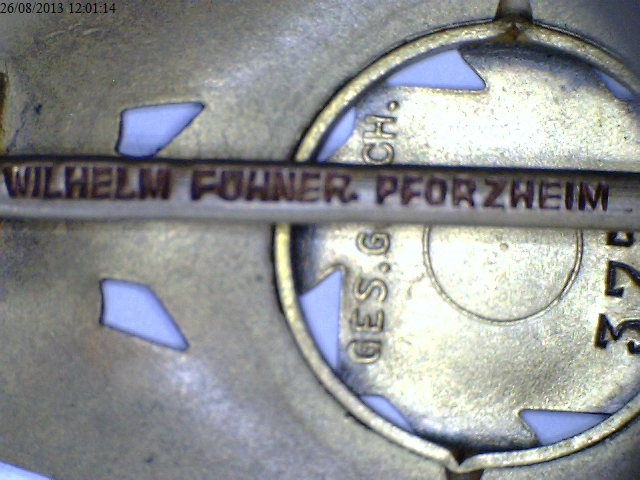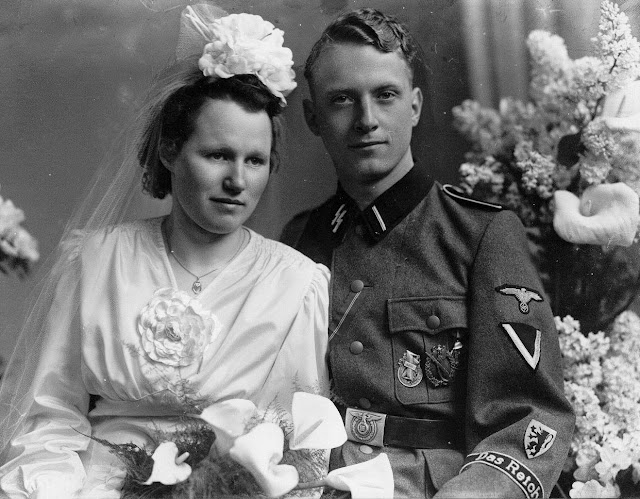Honour Badge of the Technical
Emergency Service. 1919,
1920, 1921, 1922 and 1923.
Instituted. 2nd April 1935.
Rarity – Rare, Rare, Rare, Rare, Rare.
Known Makers – WILHELM FÜHNER.PFORZHEIM, KARL HENSLER PFORZHEIM.
Rarity – Rare, Rare, Rare, Rare, Rare.
Known Makers – WILHELM FÜHNER.PFORZHEIM, KARL HENSLER PFORZHEIM.
Honour Badge of the Technical Emergency Service - Dated 1919 - Obverse.
In the winter of 1934 a special
membership pin was created to recognise the long service of its members but this
was inadequate to denote visibly the period of involvement in the
organisation.
The shortcomings of the pin were overcome on 2nd April 1935 by the introduction of the Honour Badge of the Technical Emergency Service, (Ehrenzeichen der Technischen Nothilfe) and were to be presented to those members who had joined the TeNo between 1919 and 1923, both dates to be inclusive, and who had significantly contributed to the organisation and its aims. How many of the members were eligible for the award is not known but the total number awarded is presumed to be very small.
However, in June 1936 SS-Gruppenführer and Police General Weinrich, the leader of the Technical Emergency Service, (TeNo), ordered that the wearing of the Honour Badge should cease and that it would be replaced by a cuff title. This is a black band which measures 23 mm in width and was worn on the right cuff. It was to have the date of entry into the organisation, 1919-1923, woven in Gold wire thread, which was to be flanked by a bunch of three laurel leaves.
The Technical Emergency Service - Membership Badge.
The Technical Emergency Service - Membership Badge - Reverse.
Ingenieur Hans Bätcher wearing theTeNo Member's Badge.
Ingenieur Hans Bätcher wearing theTeNo Member's Badge.
The shortcomings of the pin were overcome on 2nd April 1935 by the introduction of the Honour Badge of the Technical Emergency Service, (Ehrenzeichen der Technischen Nothilfe) and were to be presented to those members who had joined the TeNo between 1919 and 1923, both dates to be inclusive, and who had significantly contributed to the organisation and its aims. How many of the members were eligible for the award is not known but the total number awarded is presumed to be very small.
Honour Badge of the Technical Emergency Service - Date 1919.
Honour Badge of the Technical Emergency Service - Date 1920.
Honour Badge of the Technical Emergency Service - Date 1921.
Honour Badge of the Technical Emergency Service - Date 1922.
Honour Badge of the Technical Emergency Service in wear.
However, in June 1936 SS-Gruppenführer and Police General Weinrich, the leader of the Technical Emergency Service, (TeNo), ordered that the wearing of the Honour Badge should cease and that it would be replaced by a cuff title. This is a black band which measures 23 mm in width and was worn on the right cuff. It was to have the date of entry into the organisation, 1919-1923, woven in Gold wire thread, which was to be flanked by a bunch of three laurel leaves.
TENO Cuff title: 1920 and 1922.
Stellvertretender Reichsführer Erich Hampe wearing the 1919 cuff title.
The
growth of importance of the organisation and its new patronage led, in the
spring of 1944, to the Honour Badge being authorised again for wear. It was now to be worn on any uniform, not as
it had been formally only on that of the TeNo.
There was even provision for it to be worn on the left lapel of civilian
clothes. It was now accorded the new
title of the Loyal Service Badge of the Technical Emergency Service,
(Treudienstabzeichen der Technischen Nothilfe).
The Honour Badge measures 48 mm
high and 35 mm wide and weighs 14 grams.
It consists of a circular wreath of oak leaves which are slightly
concaved with a faint outline of the veins of the leaves showing. On to the wreath is superimposed a square
with its points at 12, 3 6, and 9 o'clock respectively. This exposes three oak leaves of the wreath
on either hand on the two lower sides of the box, while the upper ones expose
only half a leaf respectively. The box
has rays emanating from the centre that slightly widen towards the outer edge
line and have eight on each side, the largest at each point. The box is slightly concaved and has
superimposed upon it, at the centre, a raised cog wheel that measures 24 mm
across and 2 m from the outer edge of the teeth to the inner edge. The centre of the cog wheel is therefore
voided. Into this is placed the central
design of the badge which is raised above the cog wheel and is 1 mm in depth
and convexed. It consists of a brick red
enamelled square with raised silver edge line.
Superimposed on to the square, with its arms on to the cog wheel is a
black enamelled swastika with raised silver edge line. The swastika measures 2 mm tip to tip and is
fixed at its points to a circle which fits inside the void producing an inner
recessed line to the cog wheel. At the
centre of the swastika is a further cog wheel that measures 11 mm across from
the tips of the teeth. The rim is 2 mm across and has a capital 'T' at its
centre, in the form of a labourer's hammer with, surmounting it, a capital 'N',
all of which are finished in silver.
These emblems are the badge of the organisation.
At the top of the badge is a
stylised eagle with its feet perched on the outer edge of the cog wheel at 12
o'clock. The body and legs of the bird
run together just leaving the bird's angles and claws separate. The head is pronounced and facing to the
viewer's right, with a large beak and determined hooded eye. The wing formation is in the down swept rest
position, with a bold upper raised fletch line comprising of four small
feathers that curve upwards to the wing joint.
The wing is then a solid raised 2 mm line with an inwardly curved end
which measures 22 mm from the tip to the top of the joint. Beneath the upper curved feathers are two
rows of slightly larger feathers which are recessed and follow the line of the
upper ones, numbering four in each row.
From the outer straight line are three more similar ones with curved
tips, which are stepped down in gradients with the area between the inner line
of the wing and the body of the eagle, being cut out. The design is repeated on the opposite
hand. At the base of the wreath and the
box is a small curved panel, 3.5 mm high by 10.5 mm long on to which is
impressed the date of inception into the organisation of the recipient and can
be found with five dates, 1919, 1920, 1921, 1922 and 1923.
The reverse is plain with the
raised retaining circle being evident and held into the badge's body by two
clench marks, one on either side of the badge at 9 and 3 o'clock
respectively. The upper hinge is of good
quality construction, being an 'on its side' type. The lower hook is the standard 'C' form,
while the pin is a broad blade type with horizontal sides. On to the upper side is stamped in incused
capitals is the maker's name, WILHELM FÜHNER.PFORZHEIM or KARL HENSLER PFORZHEIM. However in some later
pieces the pin is slightly thinner and devoid of the makers mark. The reverse of the swastika and the red
enamelled plaque has usually the inscription Ges Gesch in raised letters,
although this is not always the case with badges with a date of 1922 and 1923. The issue number of the badge is found
stamped into the same place in small Arabic numerals.
Makers Mark - KARL HENSLER PFORZHEIM.
Honour Badge of the Technical Emergency Service in Case.
Honour Badge of the Technical Emergency Service - Case No 163.
It was accompanied by a citation
that measured 300 x 420 mm and had an elaborate type style in four lines,
URKUNDE, ber die Verleihung des, EHRENZEICHENS, der TECHNISCHEN NOTHILFE. Beneath the title of the recipient and the
town, a three line inscription followed; Wird mit dem Heutigen Tage das,
Ehrenzeichen der Technischen Nothilfe, mit der Jaheszahl 1919 verliehen. Beneath this is Berlin and the date, under
which, in two lines, is der Reichsfhrer der Technischen Nothilfe followed by
the awarding officer's signature. On the
left side, at the bottom, is a line drawing of the badge with the date
1919. The citation was altered for each
of the years that were represented. It
is also possible to find diverse versions of the award citation with all the
awards.
Honour Badge of the Technical Emergency Service Citation - Date 1919.
Honour
Badge of the Technical Emergency Service – Holders.
Name
|
First Name
|
Location
|
Badge Date
|
Badge No
|
Award Date
|
Schollmeyer
|
Albert
|
Berlin
- Friedenau
|
1919
|
5016
|
30.04.1936
|
Mensdorf
|
Lothar
Dr.
|
Leipzig
|
1920
|
2668
|
30.01.1936
|


















































